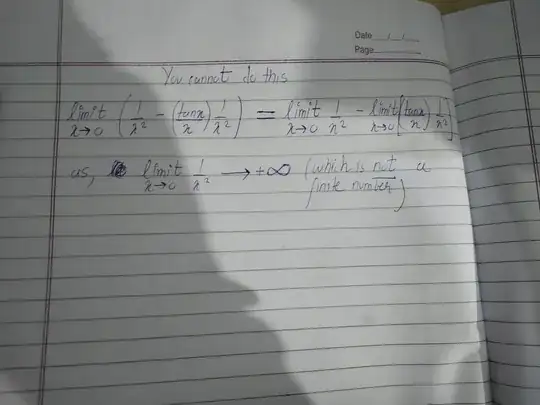Everyone here is correctly pointing out that you cannot use $\displaystyle \lim_{x\to 0} \dfrac{\tan x}{x}=1$, but they haven't stated why is that.
Now let me try to explain it to you.
Before proceeding I would like to clear a fact.
Let $f(x)$ and $g(x)$ be two functions such that $\displaystyle \lim_{x\to a}f(x)=l$ and $\displaystyle \lim_{x\to a} g(x)=m$ then,
$$\displaystyle \lim_{x\to a}\left(f(x)\pm g(x)\right) =l\pm m $$
But the converse i.e.
$$l\pm m = \displaystyle \lim_{x\to a}\left(f(x)\pm g(x)\right)\ \ \ ....(1)$$
may not be true.
I have marked this as $(1)$ because I'll be referring to it later.
You did this
$$
\lim_{x\to 0} \left({1\over x^2} - \frac{\tan x}{x^3}\right)
=\lim_{x\to 0}\left({1\over x^2} - {\tan x\over x}\cdot {1\over x^2}\right)
$$
Everything looks fine uptill here. Now you want to use this property $\displaystyle \lim_{x\to 0} \dfrac{\tan x}{x}=1$
So you will have to split this expression like this.
$$
\lim_{x\to 0}\left({1\over x^2} - {\tan x\over x}\cdot {1\over x^2}\right)
$$
$$\implies \lim_{x\to 0}{1\over x^2} - \lim_{x\to 0}\left({\tan x\over x}\cdot {1\over x^2}\right) $$
$$\implies \lim_{x\to 0}{1\over x^2} - \lim_{x\to 0}{\tan x\over x}\cdot\lim_{x\to 0} {1\over x^2} $$
Now you can use $\displaystyle \lim_{x\to 0} \dfrac{\tan x}{x}=1$ to get this
$$
\lim_{x \to 0}\frac{1}{x^2} - \lim_{x \to 0}\frac{1}{x^2}$$
Upon reaching this stage, you did this step
$$
\lim_{x \to 0} \left(\frac{1}{x^2} - \frac{1}{x^2}\right)
$$
But this is wrong as I already stated in point (1) above.
Now you'd why is that. It is because
$$\lim_{x\to 0}{\tan x\over x}\cdot\lim_{x\to 0} {1\over x^2} \neq \lim_{x \to 0} \frac{1}{x^2} $$
but
$$\lim_{x\to 0}{\tan x\over x}\cdot\lim_{x\to 0} {1\over x^2} = 1.00000000000..........0001 \cdot \lim_{x \to 0} \frac{1}{x^2} $$
This number is so close to $1$ that we just approximate it to $1$.
Therefore
$$\lim_{x\to 0}{1\over x^2} - \lim_{x\to 0}{\tan x\over x}\cdot\lim_{x\to 0} {1\over x^2} = \lim_{x\to 0} {1\over x^2} - 1.00000000000..........0001 \lim_{x \to 0} \dfrac{1}{x^2} $$
That's why I said in point $(1)$ the converse may not be true.
If you properly evaluate the limit as @Jose Carlos Santos and @roman did. You will find the answer to be $-\dfrac{1}{3}$.
You can clearly note that this answer is negative, because $$1.00000000000..........0001 \lim_{x \to 0} \frac{1}{x^2} > \lim_{x\to 0} {1\over x^2} $$
